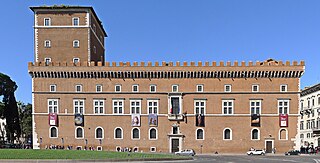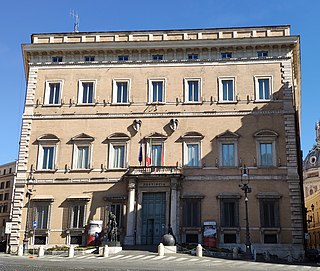
The Quirinal Hill is one of the Seven Hills of Rome, at the north-east of the city center. It is the location of the official residence of the Italian head of state, who resides in the Quirinal Palace; by metonymy "the Quirinal" has come to stand for the Italian president. The Quirinal Palace has an extension of 1.2 million square feet.

Monti is the 1st rione of Rome, identified by the initials R. I, located in Municipio I. The name literally means "mountains" in Italian and comes from the fact that the Esquiline, the Viminal Hills, and parts of the Quirinal and the Caelian Hills belonged to this rione: currently, however, the Esquiline Hill belongs to the rione Esquilino.

Colonna is the 3rd rione of Rome, identified by the initials R. III and located at the city's historic center in Municipio I. It takes its name from the Column of Marcus Aurelius in the Piazza Colonna, the rione's main piazza.

Campitelli is the 10th rione of Rome, identified by the initials R. X, and is located in the Municipio I.

Sallustiano is the 17th rione of Rome, identified by the initials R. XVII. It is located within the Municipio I and the name refers to the ancient Gardens of Sallust, which were located here.

Castro Pretorio is the 18th rione of Rome (Italy), identified by the initials R. XVIII, and it is located within the Municipio I. The rione takes its name by the ruins of the Castrum Praetorium, the barracks of the Praetorian Guard, included in the Aurelian Walls.

Campo Marzio is the 4th rione of Rome, identified by the initials R. IV. It belongs to the Municipio I and covers a smaller section of the area of the ancient Campus Martius. The logo of this rione is a silver crescent on a blue background.

The Palazzo Barberini is a 17th-century palace in Rome, facing the Piazza Barberini in Rione Trevi. Today it houses the Galleria Nazionale d'Arte Antica, the main national collection of older paintings in Rome.

The Palazzo Venezia, formerly Palace of St. Mark, is a palazzo (palace) in central Rome, Italy, just north of the Capitoline Hill. The original structure of this great architectural complex consisted of a modest medieval house intended as the residence of the cardinals appointed to the church of San Marco. In 1469 it became a residential papal palace, having undergone a massive extension, and in 1564, Pope Pius IV, to win the sympathies of the Republic of Venice, gave the mansion to the Venetian embassy to Rome on the terms that part of the building would be kept as a residence for the cardinals, the Apartment Cibo, and that the republic would provide for the building's maintenance and future restoration. The palace faces Piazza Venezia and Via del Plebiscito. It currently houses the National Museum of the Palazzo Venezia.

St Andrew's Church is a congregation of the Church of Scotland in Rome, Italy, belonging to the Church's International Presbytery. Services take place every Sunday at 11:00 a.m. in Via XX Settembre, 7 00187 Rome. Rev Aaron Stevens is acting as Interim Moderator as the charge is currently vacant.

The Via del Corso is a main street in the historical centre of Rome. It is straight in an area otherwise characterized by narrow meandering alleys and small piazzas. Considered a wide street in ancient times, the Corso is approximately 10 metres wide, and it only has room for two lanes of traffic and two narrow sidewalks. The northern portion of the street is a pedestrian area. The length of the street is roughly 1.5 kilometres.

The Temple of Hadrian was dedicated to the deified emperor Hadrian on the Campus Martius in Rome, Italy by his adoptive son and successor Antoninus Pius in 145 C.E. This temple was previously known as the Basilica of Neptune but has since been properly attributed as the Temple of Hadrian completed under Antoninus Pius. With one cella wall and eleven columns from the external colonnade surviving, the remains of the temple have been incorporated into a later building in the Piazza di Pietra, whereby its facade, alongside the architrave which was reconstructed later on, was incorporated into a 17th-century papal palace by Carlo Fontana, now occupied by Rome's Chamber of commerce. While only part of the structure remains, excavations and scholarship have provided us with information regarding its construction techniques and stylistic influences, helping us recreate the building dynamics and significance of the Temple of Hadrian in Imperial Rome.

Palazzo Valentini is a palazzo in central Rome, Italy, not far from Piazza Venezia. Since 1873 it has been the base of the provincial and prefectural administration of Rome.

Via del Babuino is a street in the historic centre of Rome (Italy), located in the rione Campo Marzio. It connects Piazza del Popolo to Piazza di Spagna and is part of the complex of streets known as Tridente.

This article covers the various places where you can find art and art-like places in the Italian capital city, Rome. These art forms are not only seen in the city's visual arts, but its structures and customs such as ancient buildings and streets. As a center of cultural for many centuries, Rome has gathered its art from distant places and times. There is art everywhere you turn in Rome due to its long and rich history. This article shows many of the artistic parts of Rome.

Via Toledo is an ancient street and one of the most important shopping thoroughfares in the city of Naples, Italy. The street is almost 1.2 kilometres (0.75 mi) long and starts at Piazza Dante and ends in Piazza Trieste e Trento, near Piazza del Plebiscito.

Palazzo Zuccari, also called Palazzetto Zuccheri, is a 16th-century residence, located at the crossroads of via Sistina and via Gregoriana, with a Mannerist 16th-century facades on the latter street and a late Baroque facade on the piazza Trinità dei Monti in the Campo Marzio neighborhood of Rome, Italy. Designed by Federico Zuccari, the house is known locally as the "House of Monsters" for the decorations on its doors and windows overlooking the via Gregoriana.

Via dei Coronari is a street in the historic center of Rome. The road, flanked by buildings mostly erected in the 15th and the 16th century, belongs entirely to the rione Ponte and is one of the most picturesque roads of the old city, having maintained the character of an Italian Renaissance street.

Piazza Farnese is the main square of the Regola district of Rome, Italy.



















